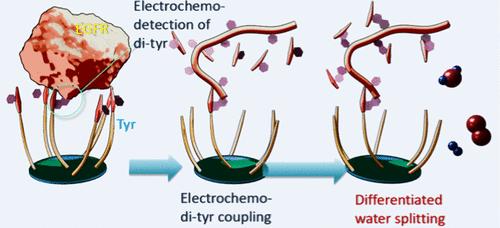Our official English website, www.x-mol.net, welcomes your
feedback! (Note: you will need to create a separate account there.)
Target-Induced On-Protein Clustering of Metal Peptide Enables Low Overpotential Water Splitting for Early Detection of Non-Small-Cell Lung Cancer
ACS Sensors ( IF 8.2 ) Pub Date : 2024-11-20 , DOI: 10.1021/acssensors.4c02858 Yi Bao Zhang, Weiming Hao, Xiatong Bian, Jingzhi Yu, Lei Zhou, Hao Lee
ACS Sensors ( IF 8.2 ) Pub Date : 2024-11-20 , DOI: 10.1021/acssensors.4c02858 Yi Bao Zhang, Weiming Hao, Xiatong Bian, Jingzhi Yu, Lei Zhou, Hao Lee

|
This study presents a novel method for the early detection of non-small-cell lung cancer (NSCLC) by employing target-induced on-protein clustering of metal–peptide complexes to facilitate low overpotential water splitting. The approach utilizes a designed peptide molecular probe composed of an EGFR-targeting motif and a copper-chelating tetrapeptide. Upon interaction with the epidermal growth factor receptor (EGFR) and divalent copper ions, the peptide probe forms a stable complex that undergoes on-protein clustering. This clustering significantly amplifies the electrochemical signal through enhanced dityrosine cross-linking and subsequent water splitting, achieving low overpotential for detection. The method was validated using clinical tissue samples and demonstrated improved sensitivity and specificity compared with traditional detection methods. This technique holds promise for earlier and more accurate diagnosis of NSCLC, leveraging the unique properties of metal–peptide interactions and electrochemical signal amplification.
中文翻译:

金属肽的靶标诱导的蛋白上聚集可实现低过电位水分解,用于非小细胞肺癌的早期检测
本研究提出了一种早期检测非小细胞肺癌 (NSCLC) 的新方法,该方法采用靶点诱导的金属-肽复合物蛋白上聚集,以促进低过电位水分解。该方法利用由 EGFR 靶向基序和铜螯合四肽组成的设计肽分子探针。在与表皮生长因子受体 (EGFR) 和二价铜离子相互作用时,肽探针形成一个稳定的复合物,该复合物经历蛋白上聚集。这种聚集通过增强的二酪氨酸交联和随后的水分解显着放大了电化学信号,从而实现了低过电位检测。该方法使用临床组织样本进行了验证,与传统检测方法相比,其灵敏度和特异性更高。该技术利用金属-肽相互作用和电化学信号放大的独特特性,有望更早、更准确地诊断 NSCLC。
更新日期:2024-11-20
中文翻译:

金属肽的靶标诱导的蛋白上聚集可实现低过电位水分解,用于非小细胞肺癌的早期检测
本研究提出了一种早期检测非小细胞肺癌 (NSCLC) 的新方法,该方法采用靶点诱导的金属-肽复合物蛋白上聚集,以促进低过电位水分解。该方法利用由 EGFR 靶向基序和铜螯合四肽组成的设计肽分子探针。在与表皮生长因子受体 (EGFR) 和二价铜离子相互作用时,肽探针形成一个稳定的复合物,该复合物经历蛋白上聚集。这种聚集通过增强的二酪氨酸交联和随后的水分解显着放大了电化学信号,从而实现了低过电位检测。该方法使用临床组织样本进行了验证,与传统检测方法相比,其灵敏度和特异性更高。该技术利用金属-肽相互作用和电化学信号放大的独特特性,有望更早、更准确地诊断 NSCLC。


















































 京公网安备 11010802027423号
京公网安备 11010802027423号